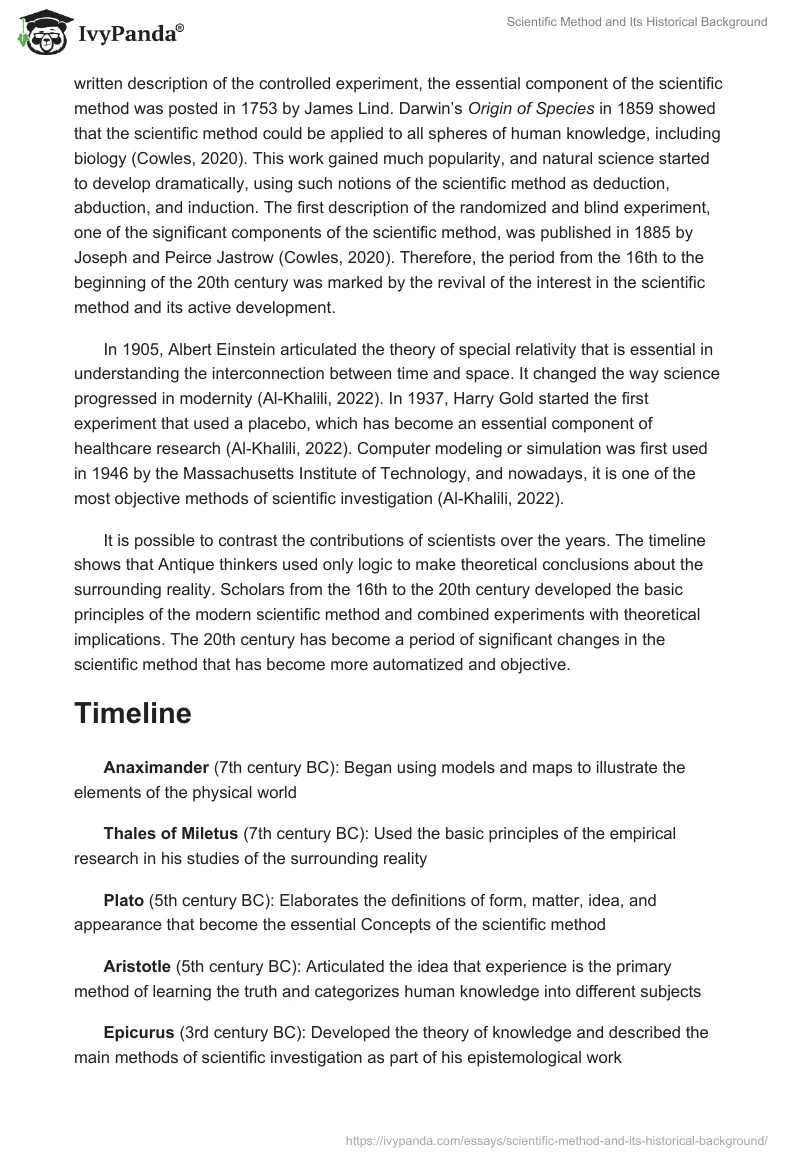The scientific method evolved with time and changed significantly to achieve the most objective results used in scholarly works. Even though the history of the scientific method dates back to ancient times, the modern view of it started to form only in the 16th century. It is possible to hypothesize that the main contribution of scientists over the years is in establishing an objective and unbiased view on conducting research that allows scholars to divide truth from false facts, sensations, and other subjective issues.
It is possible to see the basic principles of the scientific method described in the works of Antique philosophers, including Anaximander, who began using models and maps to illustrate the elements of the physical world, and Thales of Miletus, who used the basic principles of the empirical research in his studies of the surrounding reality (7th century BC) (Rudolph, 2019). In the 5th century BC, Plato elaborates the definitions of form, matter, idea, and appearance that become the essential concepts of the scientific method (Rudolph, 2019). In the 5th century BC, Aristotle articulated the idea that experience is the primary method of learning the truth and categorizes human knowledge into different subjects (Rudolph, 2019). In the 3rd century BC, Epicurus developed the theory of knowledge and described the main methods of scientific investigation as part of his epistemological work (Rudolph, 2019).
The critical detail is that Western culture had a long-term pause in the development of the scientific method after the end of Antiquity until Middle Ages. The scholars who lived after the 16th century in Europe started reviving the basic principles of scientific investigation articulated in Ancient Greece (Cowles, 2020). Copernicus was the person who inspired the beginning of the scientific revolution in Europe after he proposed the theory of the heliocentric universe. His book On the Revolutions of the Celestial Spheres was published in 1542, and it was an important event in developing the modern scientific method (Cowles, 2020).
In 1687, Newton published a book on classical mechanics entitled Mathematical Principles of Natural Philosophy that used the principles of the objective scientific method that operated only with facts (Cowles, 2020). James Lind published the first written description of the controlled experiment, the essential component of the scientific method was posted in 1753 by James Lind. Darwin’s Origin of Species in 1859 showed that the scientific method could be applied to all spheres of human knowledge, including biology (Cowles, 2020). This work gained much popularity, and natural science started to develop dramatically, using such notions of the scientific method as deduction, abduction, and induction. The first description of the randomized and blind experiment, one of the significant components of the scientific method, was published in 1885 by Joseph and Peirce Jastrow (Cowles, 2020). Therefore, the period from the 16th to the beginning of the 20th century was marked by the revival of the interest in the scientific method and its active development.
In 1905, Albert Einstein articulated the theory of special relativity that is essential in understanding the interconnection between time and space. It changed the way science progressed in modernity (Al-Khalili, 2022). In 1937, Harry Gold started the first experiment that used a placebo, which has become an essential component of healthcare research (Al-Khalili, 2022). Computer modeling or simulation was first used in 1946 by the Massachusetts Institute of Technology, and nowadays, it is one of the most objective methods of scientific investigation (Al-Khalili, 2022).
It is possible to contrast the contributions of scientists over the years. The timeline shows that Antique thinkers used only logic to make theoretical conclusions about the surrounding reality. Scholars from the 16th to the 20th century developed the basic principles of the modern scientific method and combined experiments with theoretical implications. The 20th century has become a period of significant changes in the scientific method that has become more automatized and objective.
Timeline
Anaximander (7th century BC): Began using models and maps to illustrate the elements of the physical world
Thales of Miletus (7th century BC): Used the basic principles of the empirical research in his studies of the surrounding reality
Plato (5th century BC): Elaborates the definitions of form, matter, idea, and appearance that become the essential Concepts of the scientific method
Aristotle (5th century BC): Articulated the idea that experience is the primary method of learning the truth and categorizes human knowledge into different subjects
Epicurus (3rd century BC): Developed the theory of knowledge and described the main methods of scientific investigation as part of his epistemological work
Copernicus (1542): Inspired the beginning of the scientific revolution in Europe after he proposed the theory of the heliocentric universe (On the Revolutions of the Celestial Spheres)
Isaac Newton (1687): Mathematical Principles of Natural Philosophy used the principles of the objective scientific method
James Lind (1753): The first written description of the controlled experiment,
Darwin (1859): Origin of Species showed that the scientific method could be applied to all spheres of human knowledge; introduced notions of the scientific method as deduction, abduction, and induction
Joseph and Peirce Jastrow (1885): The first description of the randomized and blind experiment
Albert Einstein (1905): The theory of special relativity
Harry Gold (1937): The first placebo experiment
The Massachusetts Institute of Technology (1946): Computer modeling or simulation
References
Al-Khalili, J. (2022). The joy of science. Princeton University Press.
Cowles, H. M. (2020). The scientific method: An evolution of thinking from Darwin to Dewey. Harvard University Press.
Rudolph, J. L. (2019). How we teach science: What’s changed, and why it matters. Harvard University Press.


